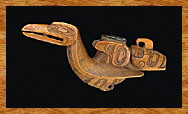(Page 1 of 3)
 |
Like other north coast peoples, the Haida believed that the souls of the deceased travelled first to the sky world in their cycle of reincarnation. Both prayers and souls could be helped on their journey by means of smoke rising from the central hearth of the house or by smoke rising from pipes. Prior to contact, the Haida used local tobacco. Pipe smoking became strongly associated with the extraordinary powers initially attributed to Europeans, particularly firearms, which not only smoked but brought instant injury or death. Many early pipes were made from the walnut of gunstocks and parts of gun barrels in order to capture and transfer the power of guns to pipes.

 |
On this wooden pipe with a brass bowl, the design of the Raven (with another bird's head on its tail) is very similar to one on a Raven rattle, with the notable absence of the human figure on its back.
Purchased from Douglas Ewing of New York City in 1976.
CMC VII-B-1659 (S92-4313) |

At some point, argillite replaced recycled gun parts for the making of pipes, but fixing upon a date for the beginning of argillite carving has been something of a challenge to scholars. One clue was found by archaeologist Knut Fladmark of Simon Fraser University, who discovered a chiefly burial inside a house floor at Lawn Hill, on the east coast south of Rose Spit. A well-sculpted argillite pipe of a clam with a human face on it is related to this burial, which associated trade goods date to before 1820.
Next to totem poles, argillite carvings are probably the best known art form of the Haida. They alone produced works in argillite, since they controlled the supply of the soft black stone, which came from Slatechuck Creek on a mountainside near the village of Skidegate. Argillaceous slate does occur elsewhere on the Northwest Coast, but the lustrous black variety found near Skidegate is unique. Although Skidegate controlled the supply of argillite, it was Masset artists who produced some of the most famous pieces. A much inferior form of the stone, red in colour with mottled yellowish inclusions, occurs as surface boulders around Masset. Works made of this stone can be considered as invariably coming from there, for it was used only by Masset artists who sometimes did not find it convenient to travel to Skidegate to obtain prime black argillite.
|